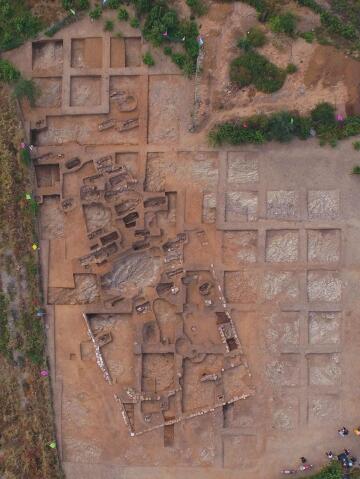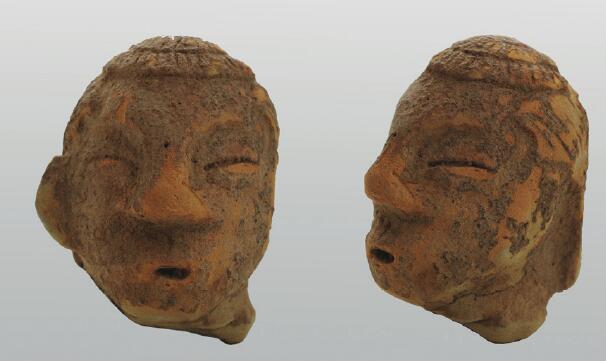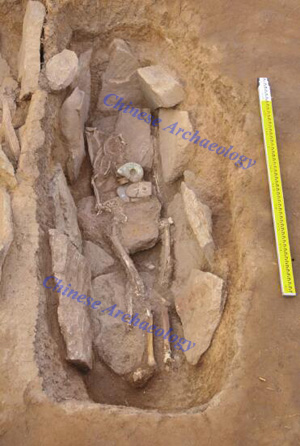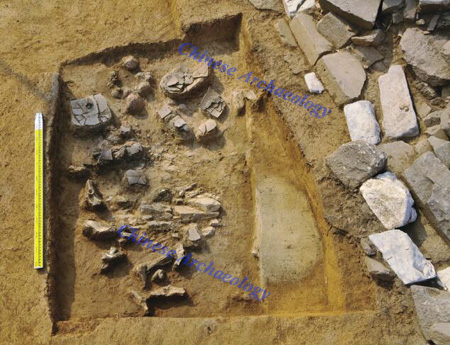Stone-mound Tomb and Sacrifice Remains Found at Banlashan Cemetery of Hongshan Cultural, Liaoning Province
From:Chinese Archaeology NetWriter:Date:2017-01-16
Banlashan cemetery was about 13 kilometers far from the center of Chaoyang city, Liaoning province, while the north of that was about 1 kilometer far from Zhaoduba town, and 278 meters above sea level.The cemetery was found during the third national archaeological survey in China, stolen already, which was severely destroyed by several times’ stolen in recent years. Approved by the State Administration of Cultural Heritage, from 2014 to 2016, Liaoning Provincial Institute of Archaeology and Cultural Relics in conjunction with Longcheng District Museum of Chaoyang city conducted the salvage excavation to the cemetery in Banlashan cemetery. The excavation area was about 1600 square meters, and archaeologists had cleared out 78 tombs, 1 sacrificial altar, 29 sacrificial pits, and unearthed a large number of cultural relics, including more than 140 pieces of jade wares.

An aerial photo of the Banlashan cemetery
The cemetery was built on the mound which was accumulated by yellow earth. The grave body was a building on the ground, but only the accumulation of Hongshan Culture was found, no accumulation of later culture. The relationship of the accumulation was simple, but the complex overlapped and broken relationship was remained.
The situation of the accumulation reflected that the construction and usage period of the cemetery experienced two variations. According to the difference, the cemetery was divided into the early and later periods. The cultural layer of the early period was named 3B, including tombs and sacrificial pits. While the layers of the later period included 2A, 2B, 3A, also with tombs and sacrificial pits included, as well as boundary walls, stone accumulation, sacrificial altar, architecture foundation and tube-shaped jars area.

Pottery made human-head figure
The grave body was made of grave mound, stone boundary wall, and stone accumulation three parts. In the early period, only the grave mound was found, stone boundary wall and stone accumulation was found in the later period.
The cemetery have two functions: one is for burying the dead; the other is for holding sacrificial events. There are three different kinds of tombs, including earth pit burial, stone-coffin burial, and stone-mound burial. In the early period, neither sub region was found in the cemetery, nor stone-mound tombs; while in the later period, the burials were mainly located at the south of the cemetery, with several tombs built around the north. The sacrificial remains included altar sacrifice and pit sacrifice, located at the north of the cemetery. In the early period, only pit sacrifice could be seen, later, altar sacrifice appeared. Around the altar, stone wall were built, sacrificial pits of different sizes were dug on the altar, as well as a building structure and a large-scale rammed activity surface, tube-shaped red clay pottery, stand and etc. were placed along the outer side of the stone wall.

Jade objects unearthed from the Banlashan Cemetery
The largest number of unearthed cultural relics was pottery, with a majority of fragments of tube-shaped red pottery, without any complete one. Few sand inclusion yellowish brown and blackish brown pottery pieces were unearthed, with Z pattern, net pattern, addition piled pattern and etc. Referring to the stone wares, chipped stone tools was the majority, as well as few polished and pressed stone tools, in the shape of axe, Yue-axe, hoe, shovel, ring, arrowhead, hammer, pounder, and etc. Jade objects were mostly unearthed inside the tombs, only few were from the accumulation, with characteristics of large number, well preserved, structured shape, fine made, and varied shapes, including dragon and bird pendant, axe, jade core, Bi disk, ring, bracelet, pendant, bead, animal-shaped handle, jade material and etc. Apart from that, more than 10 pottery or stone figures were found, some of which had large head. According to previous founding, using the figure as sacrificial object was a tradition of Hongshan Culture, made up an important part of the culture.

Tomb M12
According to the comparative analysis of the typical artifacts of the cemetery, one of the tombs was a later Hongshan cultural tomb. According to the C14 report of the bones unearthed in M4, the absolute age was about 4510±30 years, correction data was about 5305- 5045 BP.

Sacrificial pit No.4 and No.5
The excavation completely revealed the whole construction process of the stone mound tomb of later Hongshan culture. The stratigraphic relationship was clear, provided integrated materials for understanding the building process of the grave mound, making up that no remains of the stone mound of Hongshan culture was found, setting up a post for understanding the construction process of the stone mound of the late Hongshan culture located at the west of Liao River, bringing significance of studying the layout of the cemetery, burial structure, unearthed artifacts, the burial customs of Hongshan culture and the origin of Chinese civilization. (Translator: Wang Jue)

